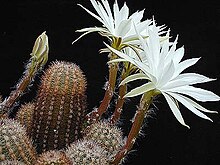Haageocereus bylesianus
| Haageocereus bylesianus | |
|---|---|

| |
| Scientific classification | |
| Kingdom: | Plantae |
| Clade: | Tracheophytes |
| Clade: | Angiosperms |
| Clade: | Eudicots |
| Order: | Caryophyllales |
| Family: | Cactaceae |
| Subfamily: | Cactoideae |
| Genus: | Haageocereus |
| Species: | H. bylesianus
|
| Binomial name | |
| Haageocereus bylesianus (Andreae & Backeb.) Lodé 2013
| |
| Synonyms | |
| |
Haageocereus bylesianus is a critically endangered species of Haageocereus from Peru.[2]
Description[edit]
The first description was in 1957 by Wilhelm Andreae and Curt Backeberg. The epithet of the species is named after the British cactus collector Ronald S. Byles.[3]
Haageocereus bylesianus has spherical to short cylindrical dark green shoots up to 8 cm long and 2 cm in diameter. The shoots branch from the base and form small pads. There is a fleshy tap root. The 12 to 14 ribs are initially notched and later divided into clear cusps. The 10 to 15 radiating dark thorns turn gray with age. They are 3 to 7 millimeters long and usually not distinguishable into central and radial spines. Occasionally 1 to 2 cm long central spines are formed.[3]
The broad, funnel-shaped, scented, white flowers are around 15 cm long. They have a very slim and long flower tube. They only last 24h and open at night.[4]
The spherical fruits are red and about 15 millimeters in size. They are thick-walled and tear open lengthways or dry up.
The plants grow very slowly and in cultivation require very well-draining growth media to avoid rots.[4]
Distribution and systematics[edit]
Haageocereus bylesianus is common in the Peruvian region of Arequipa at altitudes of 50 to 1000 m. This ground is extremely dry and condensation of fog is the major source of water.[4]
In the IUCN's Red List of Threatened Species, the species is classified as "Critically Endangered (CR)".[5]
References[edit]
- ^ Cáceres, F. (2013). "Pygmaeocereus bylesianus". IUCN Red List of Threatened Species. 2013: e.T152527A646914. doi:10.2305/IUCN.UK.2013-1.RLTS.T152527A646914.en. Retrieved 20 November 2021.
- ^ "Pygmaeocereus bylesianus in Tropicos".
- ^ a b Wilhelm Andreae and Curt Backeberg (1957) National Cactus and Succulent Journal. Volume 12, pages. 86–87.
- ^ a b c "Pygmaeocereus bylesianus Andreae & Backeb". Encyclopedia of Cacti. Encyclopedias of Living Forms. Retrieved 23 August 2020.
- ^ "The IUCN Red List of Threatened Species". IUCN Red List of Threatened Species. 2011-05-05. Retrieved 2023-09-19.
External links[edit]
 Media related to Haageocereus bylesianus at Wikimedia Commons
Media related to Haageocereus bylesianus at Wikimedia Commons Data related to Haageocereus bylesianus at Wikispecies
Data related to Haageocereus bylesianus at Wikispecies

